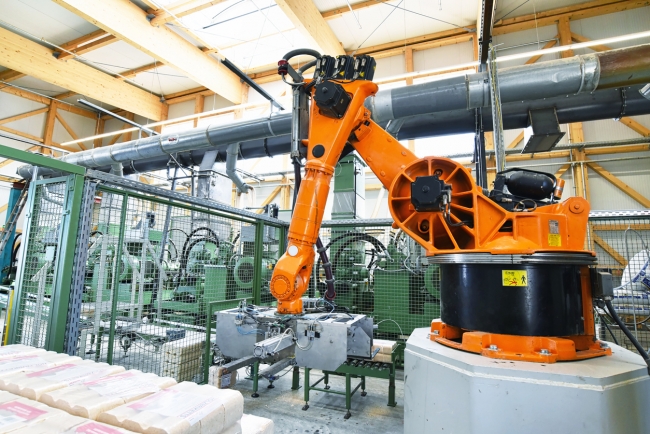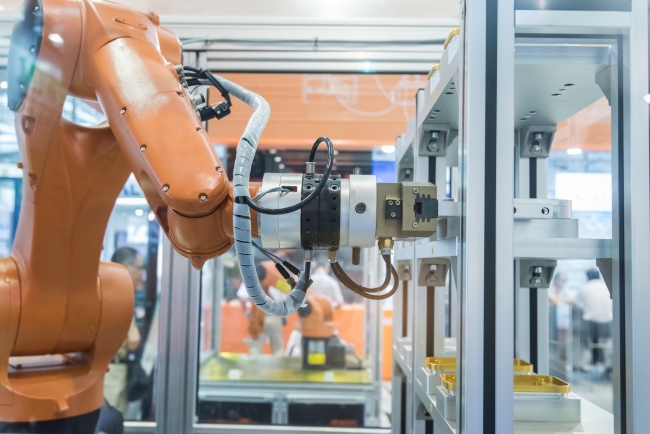5 minute read
Report highlights a record 2.7m robots work in factories around the world
The new World Robotics 2020 Industrial Robots report, released by the International Federation of Robotics (IFR), has shown a record 2.7 million industrial robots were operating in factories around the world in 2019 – an increase of 12% on 2018. Sales of new robots remain on a high level with 373,000 units shipped globally in 2019. This is 12% less compared to 2018, but still the 3rd highest sales volume ever recorded.
Milton Guerry, president of the International Federation of Robotics, said: “The stock of industrial robots operating in factories around the world today marks the highest level in history. Driven by the success story of smart production and automation, this is a worldwide increase of about 85% within five years (2014-2019). The recent slowdown in sales by 12% reflects the difficult times the two main customer industries, automotive and electrical/electronics, have experienced.”

A record 2.7m robots work in factories around the world – the UK remains at a low level with new installations slowing by 16%, according to IFR figures / Picture: Getty/iStock
Guerry added: “In addition to that, the consequences from the coronavirus pandemic for the global economy cannot be fully assessed yet. The remaining months of 2020 will be shaped by adaption to the new normal.
“A major stimulus from large-scale orders is unlikely this year. China might be an exception, because the coronavirus was first identified in the Chinese city of Wuhan in December 2019 and the country already started its recovery in the second quarter. Other economies report being at the turning point right now. But it will take a few months until this translates into automation projects and robot demand. 2021 will see recovery, but it may take until 2022 or 2023 to reach the pre-crisis level.”
Europe
Europe reached an operational stock of 580,000 units in 2019 – plus 7%. Germany remains the main user with an operational stock of around 221,500 units – this is about three times the stock of Italy (74,400 units), five times the stock of France (42,000 units) and around ten times the stock of the UK (21,700 units).
Robot sales show a differentiated picture for the largest markets within the European Union: Around 20,500 robots were installed in Germany. This is below the record year of 2018 (minus 23%) but on the same level as 2014-2016. Sales increased in France (+15%), Italy (+13%) and the Netherlands (+8%). Robotics in the UK remains on a low level – new installations slowed by 16%. The newly installed 2,000 units in the UK are around ten times less than the shipments in Germany (20,500 units), around five times less than in Italy (11,100 units) and around three times less than in France (6,700 units).
Asia
Asia remains the strongest market for industrial robots – operational stock for the region’s largest adopter China rose by 21% and reached around 783,000 units in 2019. Japan ranks second with about 355,000 units – plus 12%. India reached a new record of around 26,300 units – plus 15%. Within five years, India has doubled the number of industrial robots operating in the country´s factories.
The share of newly installed robots in Asia was about two thirds of global supply. Sales of almost 140,500 new robots in China is below the record years of 2018 and 2017, but still more than double the numbers sold five years ago (2014: 57,000 units). Installations of top Asian markets slowed – in China (minus 9%) and Japan (minus 10%).
In China, the broad majority of 71% of new robots were shipped in from foreign suppliers. Chinese manufacturers still mainly cater to the domestic market, where they gain increasing market shares. Foreign suppliers deliver some 29% of their units to the automotive industry, while it is only around 12% for Chinese suppliers. Therefore, foreign suppliers are more affected by the decline of business in the Chinese automotive industry than the domestic suppliers.
Americas
The USA is the largest industrial robot user in the Americas, reaching a new operational stock record of around 293.200 units – up 7%. Mexico comes second with 40,300 units, which is a plus of 11%, followed by Canada with 28,600 units – plus 2%.
New installations in the United States slowed down by 17% in 2019, compared to the record year of 2018. Although, with 33,300 shipped units, sales remain on a very high level representing the second strongest result of all time. Most of the robots in the USA are imported from Japan and Europe. Although, there are not many North American robot manufacturers, there are numerous important robot system integrators. Mexico ranks second in North America with almost 4,600 units – a slowdown of 20%. Sales in Canada are up 1% to a new record of around 3,600 shipped units.
South America’s number one operational stock is in Brazil with almost 15,300 units – plus 8%. Sales slowed down by 17%, with about 1,800 installations – still one of the best results ever – only beaten by record shipments in 2018.

Newly installed units in the UK (2,000) are around ten times less than in Germany (20,500) / Picture: Getty/iStock
Worldwide trend in human-robot collaboration
The adoption of human-robot collaboration is on the rise, with cobot installations growing by 11%. This dynamic sales performance was in contrast to the overall trend with traditional industrial robots in 2019. As more and more suppliers offer collaborative robots and the range of applications becomes bigger, the market share reached 4.8% of the total of 373,000 industrial robots installed in 2019. Although this market is growing rapidly, it is still in its infancy.
Globally, Covid-19 is having a strong impact on 2020 – but also offers a chance for modernisation and digitalisation of production on the way to recovery. In the long run, the key benefits of increasing robot installations remain the same: rapid production and delivery of customised products at competitive prices.
Automation enables manufacturers to keep production in developed economies – or reshore it – without sacrificing cost efficiency. The range of industrial robots continues to expand – from traditional caged robots capable of handling all payloads quickly and precisely, to new collaborative robots that work safely alongside humans, fully integrated into workbenches.